By Carolyn Christian – 50th Anniversary Committee Chair
What began in 1976 as a small gathering of friends—led by Brant and Kathi Horton and united by a shared love of winemaking—has grown into one of the most vibrant and respected wine societies in the country. No one could have imagined that casual meetings at a local wine shop and in members’ homes would blossom into a thriving nonprofit organization approaching 1,000 members and celebrating 50 extraordinary years.
In 2026, the Orange County Wine Society will proudly mark this golden milestone and we are celebrating all year long. From signature events to special surprises, historic moments to red-carpet photo ops, every part of OCWS will reflect the legacy, friendships and passion that have defined us for half a century—and we hope you’ll be part of every moment.
OC Fair Wine Competitions: Celebrating 50 Years of Excellence
Just one year after OCWS was founded, a partnership with the OC Fair gave rise to what would become our flagship events—the OC Fair Commercial Wine Competition and the OC Fair Home Wine Competition. First held in 1977, 2026 marks the 50th Annual competitions for both.
This milestone year promises to be better than ever. The Commercial Wine Competition continues to spotlight both established and emerging wineries, connecting them with the influential Southern California wine market. Meanwhile, the Home Wine Competition celebrates creativity, craftsmanship and camaraderie among amateur winemakers from across California.
The Courtyard at the OC Fair: Where the Public Celebrates With Us
The Courtyard has long been the heart of OCWS during the OC Fair—a place where award-winning wines come to life for fairgoers. While our location has evolved over the years, The Courtyard has been our home for decades.
During the 50th anniversary year, the celebration continues at the fair. Look for special displays, photo opportunities and fun surprises as we share our 50-year story with the more than 1 million visitors who pass through the fair each season.
OCWS Wine Auction: A Member Favorite Gets a Golden Twist
The OCWS Wine Auction has become one of the most anticipated member perks of the year, offering exceptional wines at a fraction of retail prices. As we prepare for future competitions and make room in our cellar, members enjoy access to more than 1,000 (4 bottle) lots of outstanding wines. In addition to great wines, the auction will feature exclusive, wine-related experiences, trips and items.
In honor of our 50th Anniversary, expect something extra special. Members who spent over $1,000 at the 2025 Wine Auction will receive a unique VIP treatment at the 2026 event.
Scholarship Program: Investing in the Future of Wine
Education has always been at the heart of OCWS. Established as a 501(c)(3), the organization expanded its mission in 1981 by launching a scholarship program to support students pursuing wine-related studies.
What began with just two institutions—UC Davis and CSU Fresno—has grown to support eight colleges and universities. In a fitting tribute to our 50th anniversary, the 2026 scholarship allocations push OCWS’s total scholarship amount past the $1 million mark. This remarkable achievement reflects decades of member generosity and commitment to the future of the wine industry. (See the full scholarship article in this newsletter for details.)
Preserving Our History: The 50th Anniversary Committee and Memorial Fund
The 50th Anniversary Committee has been hard at work preserving our rich history—scanning photos, archiving memorabilia and gathering stories from long-time members through our Vintage Member Luncheons, which will continue in 2026.
To support these efforts, we’ve launched the 50th Anniversary Memorial Fund. Donations to the fund will help preserve photos, videos and keepsakes, create new historical videos and produce a 50th anniversary coffee table book documenting OCWS’s incredible journey. Donations may be tax deductible, and every contribution helps ensure our story is preserved for generations to come.
Membership Events: 50 Years of Celebrating Together
Our official 50th anniversary celebrations kick off on January 11, 2026, with a special 50th Anniversary Bubbles ’n’ Brunch at the Orange County Mining Company—a longtime member favorite. While the event is currently sold out, members are encouraged to contact the office to join the waitlist.
OCWS has always been about its members. From early membership barbecues and legendary chili cook-offs to holiday celebrations and social gatherings, community has been our hallmark.
Today, we continue that tradition with New Member Mixers and Spring and Fall Socials—and for our 50th Anniversary, the Fall Social will take a fun step back in time with a 1970s Disco Party, honoring the decade when OCWS was born.
Winery Programs: Honoring the Best of the Best
Another cornerstone of OCWS is our Winery Program, which grew out of year-round monthly meetings featuring winemakers sharing their stories and wines.
Today, the program runs from January through April or May, with each month highlighting a winery that earned top honors in previous competitions. 2026 is no exception, with all participating wineries earning Double Gold medals at the 2025 OC Fair Commercial Wine Competition. The lineup includes wineries that have been around decades (Trentadue Winery and Dry Creek Vineyard), and those who have been around only a few decades (Miro Cellars, Macchia and Graveyard Vineyards) all with the common theme of achieving great acclaim with their wines.
Join the Celebration—All Year Long
Throughout 2026, look for the OCWS red carpet at events, where you can snap photos, record videos and share your favorite OCWS memories. Be sure to pick up your 50th anniversary logo merchandise, available through donations to the 50th Anniversary Fund or by purchasing items from our merchandise coordinator, Courtney—or both!
Thank you for being part of the Orange County Wine Society’s remarkable 50-year journey. Here’s to the friendships, the memories, the wines—and to the next 50 years. Cheers!


















